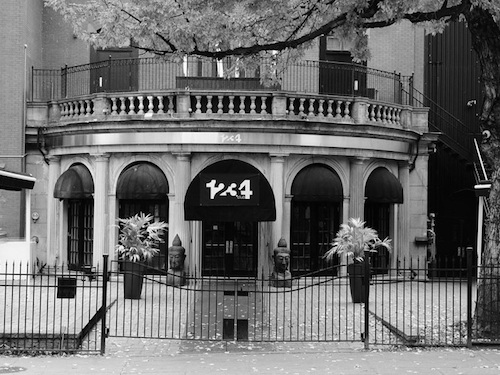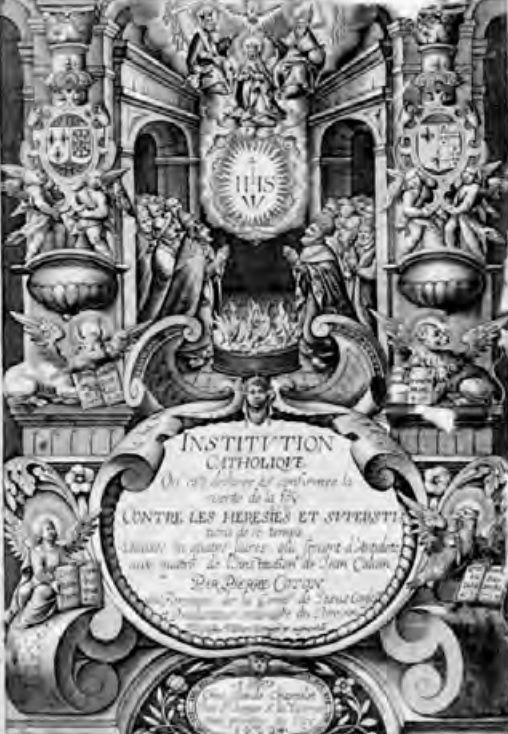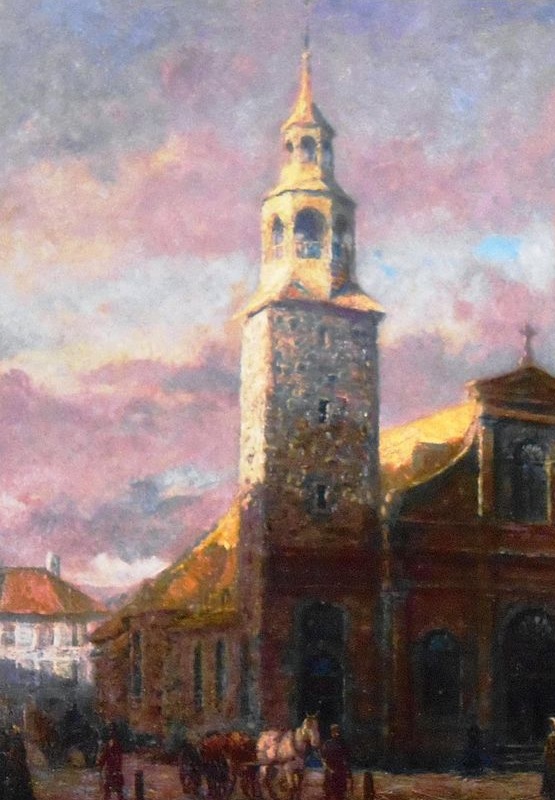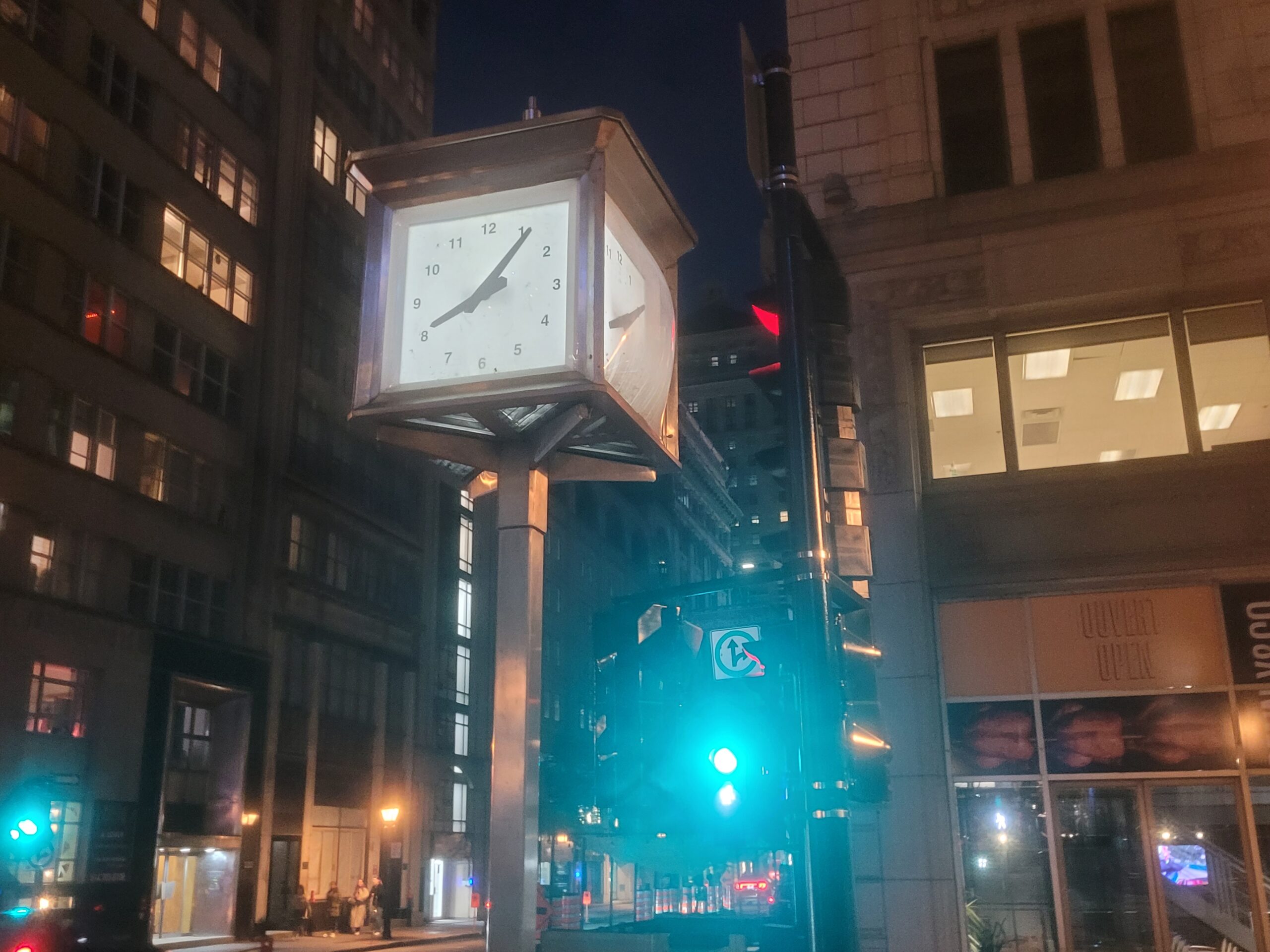While noted for their historical charm and timekeeping abilities, some of Montreal’s clocks are reputed to be haunted. Most of Montreal’s haunted clocks are located on St. James Street, an area associated with the extreme desecration of French colonial cemeteries by various financial corporations.
Welcome to the sixty-ninth installment of the Haunted Montreal Blog!
With over 450 documented ghost stories, Montreal is easily the most haunted city in Canada, if not all of North America. Haunted Montreal dedicates itself to researching these paranormal tales, and the Haunted Montreal Blog unveils a newly researched Montreal ghost story on the 13th of every month!
This service is free and you can sign up to our mailing list (top, right-hand corner for desktops and at the bottom for mobile devices) if you wish to receive it every month on the 13th!

We are also thrilled to announce that with new public health measures in place, we are re-booting two of our outdoor haunted experiences with a maximum of 8 clients each:

We are also offering our Virtual Ghost Tour on demand!
Both public and private sessions are available! More details are below in our Company News section!
This month we examine Montreal’s 1742 Sorcery Trial. During the era of New France, sorcery was considered a Crime Against the Church and those found guilty were severely punished and even exiled. In 1742, a French soldier named Francois-Charles Havard de Beaufort was stationed in Montreal. Known for his parlor tricks and slight-of-hand, authorities accused him of sorcery after he tried to conjure the image of a thief in a mirror.
Haunted Research
In 1742, Montreal was rocked by a sensational trial about sorcery. A French soldier named Francois-Charles Havard de Beaufort, stationed in Montreal, was accused by authorities of practicing sorcery after rumors spread about his attempts to cast a magic spell to discover the identity of a thief.
François-Charles Havard de Beaufort had a reputation in the Montreal region as an entertainer and a “sorcerer.” Having an ingenious mind and a solid education for the period, he used his card and knife tricks to divert and amuse spectators. By his own admission, he also used his trickery to “intimidate ordinary people in serious matters.”

Born in Paris in 1715, François-Charles Havard de Beaufort would receive an excellent education before eventually joining the French Army.
In the 1730s, he was deployed to Montreal in the colony of “New France” with the Compagnie LaFresnière.
Now known as François-Charles Havard de Beaufort dit Lavocat, he garnered a reputation as a parlor magician and expert in sleight-of-hand tricks.
In 1737, Havard de Beaufort moved into the realm of divination. The wife of Jacques Testard de Montigny, Marie de La Porte de Louvigny, had had a valuable ring stolen.

Havard de Beaufort offered to find the thief “by some craftiness and card tricks”, but ultimately was unable to do so.
Five years later, Havard de Beaufort would make another attempt at divination.
On June 28, 1742, he learned that a shoemaker named Charles Robidoux was robbed of 300 livres and that the thief had not been caught.

Given that 300 livres was a huge sum at the time, Havard de Beaufort offered the shoemaker a solution to catch the criminal. For the sum of just 20 livres, he would cast a spell to conjure up an image of the thief’s face in a mirror.
Robidoux agreed to the offer and invited a dozen relatives, friends and neighbors to his home that evening to witness the divination and sorcery ceremony.
After sundown, those invited entered the home of Charles Robidoux to attend the séance. Havard de Beaufort created a mysterious atmosphere by setting several items upon a table with a white tablecloth, including a small bottle of olive oil, powdered rosin, two candles and a mirror. He also included three packages of gunpowder, one red, one black and one yellow.
He turned the mirror upside-down on a towel on the table and placed the two burning candles on either side. He also ordered the fireplace to be covered.

Havard de Beaufort then produced a book of prayers called the Verba Jesu Christi ex Evangeliis and began reading verses while sprinkling the powder on the back of the mirror. Once there was a lot of powder on the back of the mirror, he placed a crucifix on the pile. The crucifix had been given to him by an attendee named René-Charles Laigu, dit Lanoue.
Havard de Beaufort then began pouring a mixture of olive oil, gunpowder, and powdered rosin, which he called “viper oil”, onto the four sides of the crucifix. He then proceeded to dry the mixture with a candle flame.
Once it was dry, he prepared three slips of paper and he poured a little gunpowder into each one. Havard de Beaufort then asked that the candles be extinguished, plunging the room into darkness. Next, he picked up the mirror and began reciting more Latin prayers. He then announced that the thief’s face had appeared in the mirror and ordered that the fireplace be uncovered.
The anxious crowd looked at the mirror and realized that there was no image.

The spell had failed.
Havard de Beaufort continued his rituals aby tossing the gunpowder slips into the fireplace and reading from the Gospel, but after an hour of “divinations and prognostications” he had to admit that he was unable to identify the thief.
The next day, the news of this sorcery séance spread rapidly throughout Montreal. With all of the gossip, it wasn’t long before city authorities caught wind of the story.
The following day the judicial authorities had Havard de Beaufort arrested and imprisoned, along with Charles Lanoue, Charles Robidoux and his wife Anne Lehoux, All three were accused of being accomplices.

It is noteworthy that Montreal was a very Catholic city at the time and that sorcery was considered a Crime Against the Church.
In 1624, the Catholic Church published a doctrine called Institution catholique où est déclarée et confirmée la vérité de la foy contre les hérésies et superstitions de ce temps (Catholic institution where the truth of faith against the heresies and superstitions of this time is declared and confirmed).

Essentially, this doctrine outlawed all forms of sorcery, witchcraft and spell-casting and made them punishable crimes against God.
In France, following the edict, thousands of accused sorcerers, heretics and witches were burned alive, drowned or otherwise executed. While punishments in “New France” were more lenient, the four prisoners worried what might become of them.

Jacques-Joseph Guiton de Monrepos, the lieutenant general for civil and criminal affairs in Montreal, investigated the case.
The lieutenant general accused Havard de Beaufort of “having profaned the text of the New Testament as well as the representation of Jesus Christ crucified, by using them both for prognostications and other profane and unlawful uses.”
Havard de Beaufort explained that he had not intended “to profane his God” but rather to intimidate the spectators in hopes of making the thief confess.
After a lengthy trial, on August 13, 1742, Havard de Beaufort was found guilty of “profanations of holy objects” and was sentenced to serve five years of hard labour on the King’s galleys. His sentence included making the amende honorable, or formal amends, on a market day before the main door of the Notre-Dame Church.

The amende honorable often served as a complement to other punishments. Publicly shaming a criminal was seen as important because it elicited their confession and request for forgiveness, effectively deterring others from the same crime.
For the amende honorable, Havard de Beaufort would be taken to the church by hangman Mathieu Léveillé. There he would have to wear signs on his back and chest identifying him as a “sorcerer” while receiving corporal punishment.

Shoemaker Charles Robidoux was convicted of having assisted François-Charles Havard de Beaufort’s “prognostications and divinations.” Given that he had permitted the sorcery in his own home, Robidoux was banished from Montreal for three years.
Charles Lanoue received the same punishment after the court convicted him of supplying Havard de Beaufort with the prayer book and crucifix.

Both men were also sentenced to make the amende honorable in front of the church, on their knees and dressed only in tunics. Their sentences also included corporal punishment.
Anne Lehoux was acquitted given a lack of evidence of her involvement in planning the sordid affair.
In reaction this “sacrilege,” on September 10, 1742, Bishop Pontbriand Dubreil issued a pastoral order to the citizens of Montreal condemning sorcery.

He also ordered an adoration of the cross during a procession from the Notre-Dame Church to the Bonsecours Chapel.
Given the severity of the sentences, authorities granted an appeal in compliance with the law at the time.
On September 17, 1742, the Conseil Supérieur in Quebec City upheld the guilty verdicts reached by the Montreal tribunal. However, the court decided to reduce the severity of the sentences.
The court reduced Havard de Beaufort’s time to be served on the King’s galleys from five years to just three. However, it also added public flogging to the sentence.

Charles Lanoue and Charles Robidoux’s sentences of banishment were withdrawn and instead they had to appear before the authorities to be reprimanded. They were both also fined three livres, to be paid to the King of France..
On October 5, 1742, the executioner, Mathieu Léveillé, carried out the sentences of the Conseil Supérieur in Montreal. Havard de Beaufort was flogged in public in front of the church while making his amende honorable.
In the autumn of 1742, François-Charles Havard de Beaufort was sent away on the King’s ship to France to serve his sentence on the King’s galleys.

He was never heard from again.
Over a year later, the bishop demanded that the “desecrated crucifix” be given to him. On March 1, 1744, he decided to entrust it to the Nuns of the Hôtel-Dieu of Quebec, who had made an amende honorable and taken general communion at the time of the desecration to atone for the “sacrilege.” The “desecrated crucifix” was put on display and later became the subject of a Pope-blessed veneration on the first Friday of every October, a tradition that continues to this very day.

Just eighteen years later, Montreal would capitulate to British forces and the whole issue of sorcery began to fade as new laws came into place and the Catholic Church lost its monopoly on religion in the city.
Today, magic is no longer illegal in Montreal. Indeed, it is practiced by many devotees such as Tarot card readers, certain religious denominations and illusionists. The 1742 Montreal Sorcery Trial is a poignant reminder of the old days when the Catholic Church ruled the city with an iron fist and meted out serious punishment for any violation of religious doctrine.
Company News
Haunted Montreal is thrilled to announce that new public health measures in place allow small gatherings outdoors! We are now permitted to run outdoor tours and activities with a maximum of 8 clients.
As such, we have re-booted two of our outdoor haunted experiences:

We are also offering our Virtual Ghost Tour on demand in both English and French.
Both public and private sessions are available!
Private tours of up to 8 people are also available for a fixed rate of only $160.
While clients can request any date, time and operating tour, they are based on the availability of our actors and must end at least one hour before the 9:30 pm curfew.
Email info@hauntedmontreal.com to book a private tour!

For Health and Safety reasons, Haunted Montreal provides face masks and hand sanitizer. All of our walking tours and haunted experiences practice social distancing.
Please spread the word to those who might be interested in a Haunted Montreal experience!
Haunted Montreal would like to thank all of our clients who attended a ghost walk, haunted pub crawl, paranormal investigation or virtual event during the 2020 – 2021 season!
If you enjoyed the experience, we encourage you to write a review on our Tripadvisor page, something that helps Haunted Montreal to market its tours.

Lastly, if you would like to receive the Haunted Montreal Blog on the 13th of every month, please sign up to our mailing list.
Coming up on June 13: The Haunted Funicular Trail
Starting near the fire station on Mount Royal and heading in a straight line to the Olmsted Road is probably the most haunted trail on the mountain. Once the site of a funicular railway, today McGill students avoid this trail at night due to persistent rumours about the ghost of a man named John Jack McLean. After having died by suicide in 1906, McLean’s ghost haunted the funicular until it was dismantled in 1918. Today, he is said to still roam the area, terrorizing those foolish enough to venture on the old funicular route after sundown.

Donovan King is a postcolonial historian, teacher, tour guide and professional actor. As the founder of Haunted Montreal, he combines his skills to create the best possible Montreal ghost stories, in both writing and theatrical performance. King holds a DEC (Professional Theatre Acting, John Abbott College), BFA (Drama-in-Education, Concordia), B.Ed (History and English Teaching, McGill), MFA (Theatre Studies, University of Calgary) and ACS (Montreal Tourist Guide, Institut de tourisme et d’hôtellerie du Québec). He is also a certified Montreal Destination Specialist.




Fascinating! Thanks.